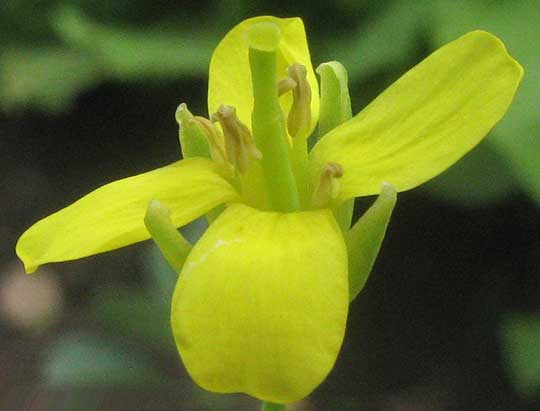
In the garden there's cabbage, Brussels sprouts, radishes, cauliflower, broccoli, kale, turnips, and mustard itself (mustard greens); and in abandoned lots, along sidewalks, and maybe around the corner of your house maybe you'll meet weedy Bitter Cress, Peppergrass, and Shepherd's Purse. They're all members of the big Mustard Family, the Brassicaceae. The family embraces about 3780 species in some 338 genera, and is of nearly worldwide distribution, especially in the Temperate Zone. The flowers in the picture belong to a garden plant, Southern Giant Mustard, Brassica juncea, so good cooked up as mustard greens eaten with buttery cornbread.
Since Mustard Family members usually, but not always, blossom in the spring, they tend to have white or yellow blossoms -- bright colors highly visible to pollinators in spring's relatively dim sunlight.

More important to us identifiers, however, is the fact that Mustard Family flowers are structured in such a unique way that they can be identified at a glance, anyplace in the world. At the left, a Bok Choy or Pak Choi flower, Brassica rapa ssp. chinensis, is a good example.
Here's the secret, and if you look hard you can see what we're talking about in the Bok Choy flower. For basic flower terms you may want to review, visit our Standard Blossom page. Mustard Family flowers have:
- four petals (very rarely none) alternating with four sepals
- six stamens
- of the six stamens, two are shorter than the other four
If all plant families were so easy to define, plant identification would be a simple matter of memorizing "flower formulas." But, they're not. Nonetheless, it's good to run into such neat formulations from time to time.

Also seen in the above Bok Choy flower is a slender, green ovary in the blossom's center, with a knobby stigma atop its style. In the Mustard Family, usually the stigma, style and ovary mature into a capsular-type fruit of a special kind. Normally the capsule splits along two sides, revealing two compartments, with a kind of thin wall between the two compartments, and seeds developed on both sides of the wall, as seen at the right with capsules of Southern Giant Mustard.
Such capsules can be called by the special name of siliques if their length is three or more times the capsule's width, or silicles if their length is less than three times their width. However, the Mustard Family, being so large and diverse, sometimes produces other kinds of fruits, so there's not nice "formula" for recognizing mustard fruits. Still, the backyard naturalist can develop a feeling for what a Mustard Family fruit looks like, which helps us know most fruiting mustards when we meet them.